Thanks to Dorka Palotay of SophosLabs for her behind-the-scenes work on this article.
Last month, we received a few queries asking about a strain of ransomware going by the name of Satan.
Those queries were along the lines of, “What do you detect it as?”
The simple answer is Troj/Ransom-ECZ, which is what we replied back then, but there’s a backstory to the Satan malware family that we thought was worth covering, too.
Cybercriminals have long used themes like the devil, the occult and what you might rather loosely call “the dark arts” as inspiration for malware names: Dark Avenger, Necropolis, Mydoom, Natas (which is Satan backwards) and SatanBug are just a few examples
But there’s one aspect of the Satan ransomware that isn’t old-school, and that’s what we’re looking at in this article: its business model.
In its own words, the malware part of Satan is simply explained:
Satan is a ransomware, a malicious software that once opened in a Windows system, encrypts all the files, and demands a ransom for the decryption tools.
But Satan is also an online crimeware service:
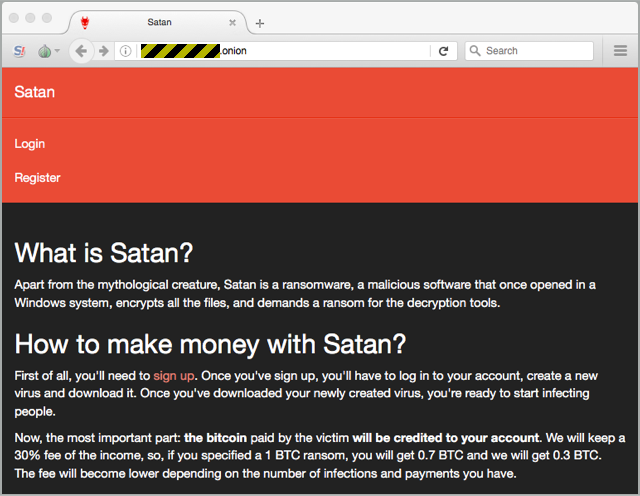
As you can see from the welcome screen on Satan’s website, which you access using Tor via a .onion address on the dark web, this ransomware is backed by a cloud service you sign up for.
Satan has brazenly copied the business model of many legitimate online services such as iTunes and eBay: joining up is free, but you pay-as-you-go on a percentage basis when you put business through the site.
The Satan service claims to:
- Generate a working ransomware sample and let you download it for free.
- Allow you to set your own price and payment conditions.
- Collect the ransom on your behalf.
- Provide a decryption tool to victims who pay up.
- Pay out 70% of the proceeds via Bitcoin.
The service (we'll use that word without quotation marks, but you may infer them if you wish) even supports optional two-factor authentication based on a public-private key pair, just like SSH, and a CAPTCHA to make automatic mass signups more difficult:
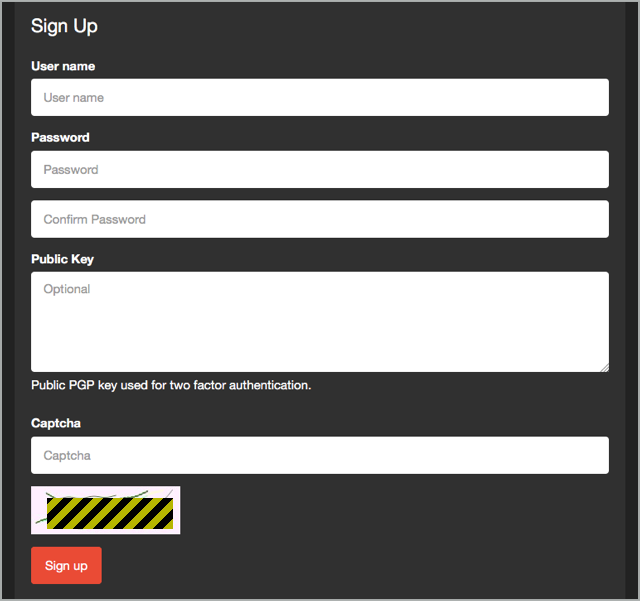
Once you have a login, you can begin to generate ransomware samples, tailored to your own price point.
You can choose an initial ransom, starting at BTC 0.1 (about $125 on 2017-03-07), the number of days you want to keep the price at its starting point, and a "ramp up" factor by which the ransom will increase after the initial period:
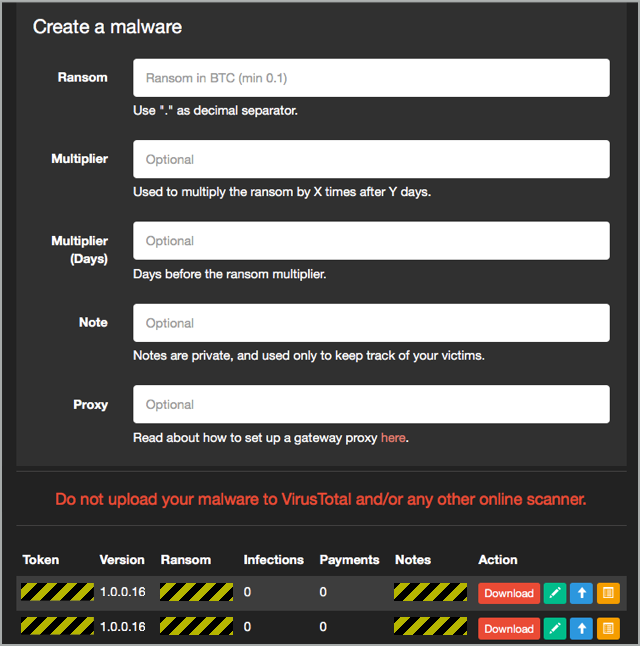
Once you've created a sample, you can not only download it to start attacking potential victims, but also generate a series of supporting files that will help you to use it in an attack.
Notably, the Satan website helps you create scripts in both Powershell and Python that will scramble your ransomware samples using an XOR encoding algorithm.
That way, the files you publish online for your victims to download won't look obviously like Windows programs (EXE files):
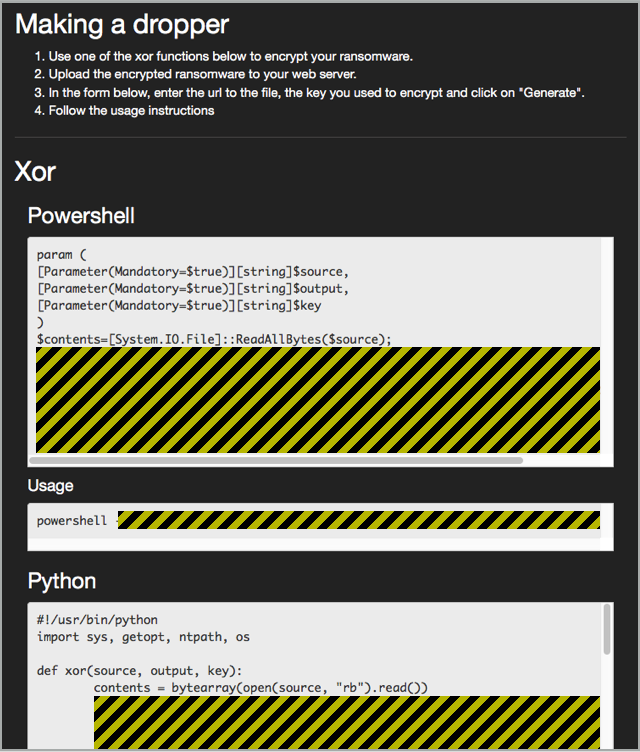
Of course, once you have scrambled your ransomware files, you can't just send the files or links to your victims and expect them to work, because the files will arrive in scrambled form and won't run.
The Satan service helps you over that step, too, by creating either an HTML page or a Microsoft Word macro to do the job of downloading, unscrambling and auto-launching the decoded malware.
You then convert the HTML into CHM (compiled HTML) format or embed the generated Word macro into a Word document, thus creating a malware downloader file you can send as an email attachment and entice your victim to open it.
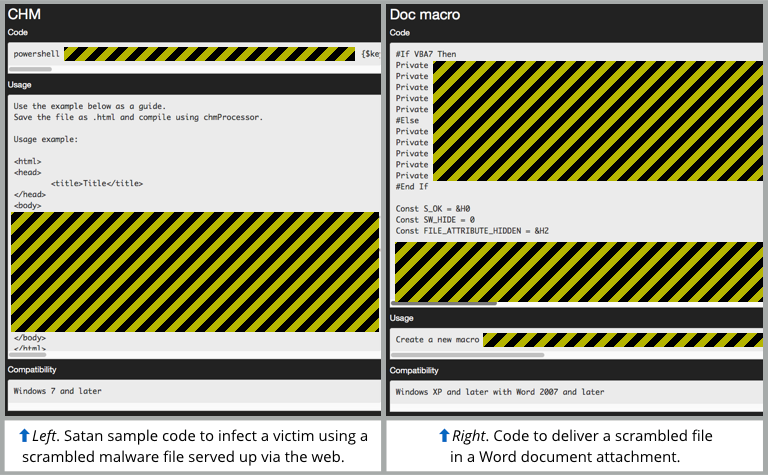
If you do manage to infect a prospective victim, they’ll be instructed to pay the ransom you specified, but into a bitcoin wallet operated by the crooks:
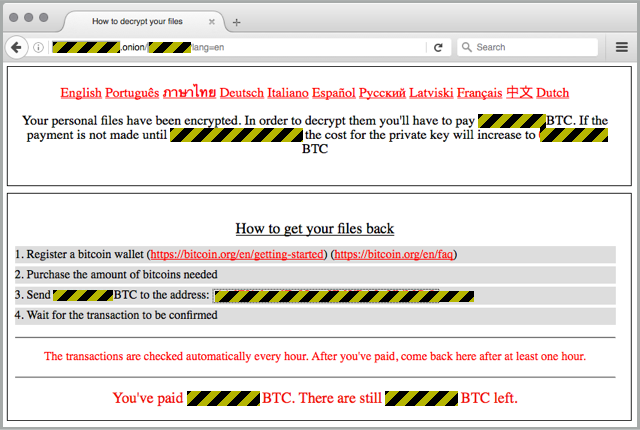
You’re then expected to trust the crooks to be honest about all the payments they receive, and to cough up 70% of every ransom payment into a bitcoin address you supply them.
What to do?
We shouldn’t have to say this, but the answer is dead simple: DON’T.
Deliberately sending out malware in the hope of infecting victims is illegal in most jurisdicitions; actually infecting them just makes a bad thing worse; and demanding money with menaces after infecting them is worse still.
If you try this and get caught, don’t expect too much sympathy from the court.
LEARN MORE
As always, the best defence against ransomware of any sort is not to get infected in the first place, so we’ve published a guide entitled How to stay protected against ransomware that we think you’ll find useful:
You might also enjoy our Techknow podcast Dealing with Ransomware:
(Audio player above not working? Listen on Soundcloud or access via iTunes.)

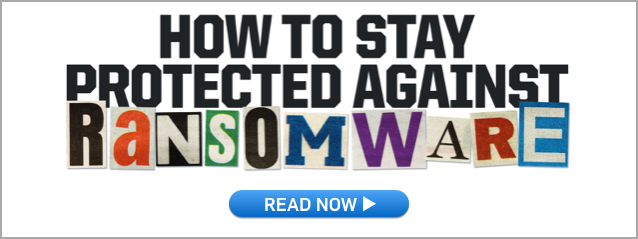
Kasun
Pyramid scheme bundled to ransomware. Bad things are connected to more bad things and make things worst.
Paul Ducklin
Only two levels in this pyramid, though :-)
Little Duck
Can you explain more on the part of the HTML file?
I mean “Set up an innocent-looking web page that does the dirty work, and entice your victims to visit it;”
I understand the Marco will encrypt everything but how does HTML page help? The victim got infected when he/she visits that HTML page?
Paul Ducklin
I misled you a bit there, I’m afraid :-) I have cleared up the article now: you’re actually supposed to take the generated HTML file and convert it into CHM format (compiled HTML). When opened locally, CHM files – like documents with macros, or JavaScript files – act as scripts that aren’t limited by your browser sandbox, so they can download files onto your hard disk, modify them, and then execute them, as happens here.
So you don’t send the victim a link to the HTML page, you send the HTML page to them as an email attachment, packaged into CHM format.
In other words, the CHM downloader script is just an alternative approach to using a document file with macros.
Thanks for the useful question!
Little Duck
Thanks for the clarification! I understand how that CHM works now.
BLUTCH
Excellent article !